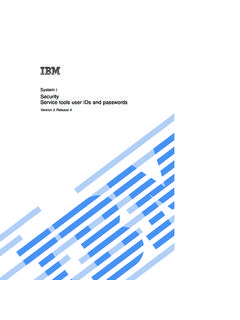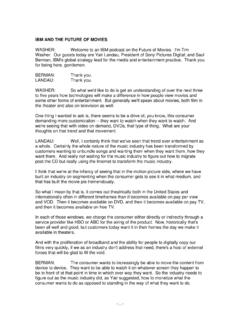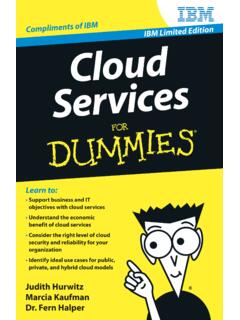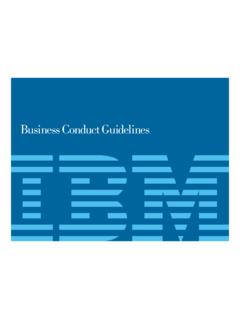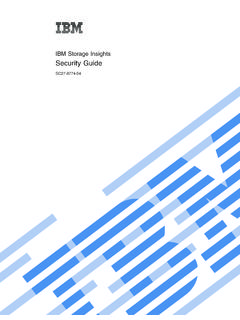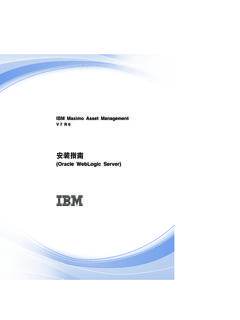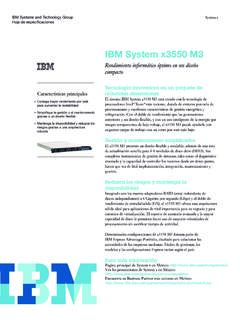Transcription of Generating Test Cases From Use Cases - IBM
1 Copyright Rational Software 2001 Generating Test Cases From Use Cases by Jim Heumann Requirements Management Evangelist Rational Software In many organizations, software testing accounts for 30 to 50 percent of software development costs. Yet most people believe that software is not well tested before it is delivered. That contradiction is rooted in two clear facts: First, testing software is a very difficult proposition; and second, testing is typically done without a clear methodology. A widely-accepted tenet in the industry -- and an integral assumption in the Rational Unified Process (RUP ) -- is that it is better to start testing as early in the software development process as possible. Delaying the start of testing activities until all development is done is a high-risk way to proceed.
2 If significant bugs are found at that stage (and they usually are), then schedules often slip. Haphazard methods of designing, organizing, and implementing testing activities and artifacts also frequently lead to less-than-adequate test coverage. Having a straightforward plan for how testing is done can help increase coverage, efficiency, and ultimately software quality. In this article, we will discuss how using use Cases to generate test Cases can help launch the testing process early in the development lifecycle and also help with testing methodology. In a software development project, use Cases define system software requirements. Use case development begins early on, so real use Cases for key product functionality are available in early iterations. According to the RUP, a use case " fully describes a sequence of actions performed by a system to provide an observable result of value to a person or another system using the product under development.
3 " Use Cases tell the customer what to expect, the developer what to code, the technical writer what to document, and the tester what to test. For software testing -- which consists of many interrelated tasks, each with its own artifacts and deliverables -- creation of test Cases is the first fundamental step. Then test procedures are designed for these test Cases , and finally, test scripts are created to implement the procedures. Test Cases are key to the process because they identify and communicate the conditions that will be implemented in test and are necessary to verify successful and acceptable implementation of the product requirements. They are all about making sure that the product fulfills the requirements of the system. Although few actually do it, developers can begin creating test Cases as soon as use Cases are available, well before any code is written.
4 We will discuss how to do this, and the advantages you can reap from it, below. An Introduction to Use Cases Use Cases are based on the Unified Modeling Language (UML) and can be visually represented in use- case diagrams. Figure 1 shows a use- case diagram depicting requirements for a university course registration system. Figure 1: Use case Diagram for a University Course Registration System The ovals represent use Cases , and the stick figures represent "actors,". which can be either humans or other systems. The lines represent communication between an actor and a use case . As you can see, this use- case diagram provides the big picture: Each use case represents a big chunk of functionality that will be implemented, and each actor represents someone or something outside our system that interacts with it.
5 It is a significant step to identify use Cases and actors, but now there is more to be done. Each use case also requires a significant amount of text to describe it. This text is usually formatted in sections, as shown in Table 1. Table 1: Format for a Use- case Textual Description Use case Section Description Name An appropriate name for the use case (see Leslee Probasco's article in the March issue of The Rational Edge). Brief Description A brief description of the use case 's role and purpose. Flow of Events A textual description of what the system does with regard to the use case (not how specific problems are solved by the system). The description should be understandable to the customer. Special Requirements A textual description that collects all requirements, such as non-functional requirements, on the use case , that are not considered in the use- case model, but that need to be taken care of during design or implementation.
6 Preconditions A textual description that defines any constraints on the system at the time the use case may start. Post conditions A textual description that defines any constraints on the system at the time the use case will terminate. The most important part of a use case for Generating test Cases is the flow of events. The two main parts of the flow of events are the basic flow of events and the alternate flows of events. The basic flow of events should cover what "normally" happens when the use case is performed. The alternate flows of events covers behavior of an optional or exceptional character relative to normal behavior, and also variations of the normal behavior. You can think of the alternate flows of events as "detours" from the basic flow of events. Figure 2: Basic Flow of Events and Alternate Flows of Events for a Use case Figure 2 represents the typical structure of these flows of events.
7 The straight arrow represents the basic flow of events, and the curves represent alternate flows. Note that some alternate flows return to the basic flow of events, while others end the use case . Both the basic flow of events and the alternative flows should be further structured into steps or subflows Register For Courses Basic Flow 1. Logon This use case starts when a Student accesses the Wylie University Web site. The system asks for, and the Student enters, the student ID. and password. 2. Select 'Create a Schedule'. The system displays the functions available to the student. The student selects "Create a Schedule.". 3. Obtain Course Information The system retrieves a list of available course offerings from the Course Catalog System and displays the list to the Student. 4. Select Courses The Student selects four primary course offerings and two alternate course offerings from the list of available course offerings.
8 5. Submit Schedule The student indicates that the schedule is complete. For each selected course offering on the schedule, the system verifies that the Student has the necessary prerequisites. 6. Display Completed Schedule The system displays the schedule containing the selected course offerings for the Student and the confirmation number for the schedule. Figure 3: Textual Description for the University Course Registration Use- case Basic Flow of Events Figure 4 shows a few alternate flows. Register For Courses Alternate Flows 1. Unidentified Student In Step 1 of the Basic Flow, Logon, if the system determines that the student ID and/or password is not valid, an error message is displayed. 2. Quit The Course Registration System allows the student to quit at any time during the use case .
9 The Student may choose to save a partial schedule before quitting. All courses that are not marked as "enrolled in" are marked as "selected" in the schedule. The schedule is saved in the system. The use case ends. 3. Unfulfilled Prerequisites, Course Full, or Schedule Conflicts In Step 5 of the Basic Flow, Submit Schedule, if the system determines that prerequisites for a selected course are not satisfied, that the course is full, or that there are schedule conflicts, the system will not enroll the student in the course. A. message is displayed that the student can select a different course. The use case continues at Step 4, Select Courses, in the basic flow. 4. Course Catalog System Unavailable In Step 3 of the Basic Flow, Obtain Course Information, if the system is down, a message is displayed and the use case ends.
10 5. Course Registration Closed If, when the use case starts, it is determined that registration has been closed, a message is displayed, and the use case ends. Figure 4: Textual Description for University Course Registration Use- case Alternate Flows As you can see, a significant amount of detail goes into fully specifying a use case . Ideally, the flows should be written as "dialogs" between the system and the actors. Each step should explain what the actor does and what the system does in response; it should also be numbered and have a title. Alternate flows always specify where they start in the basic flow and where they go when they end. Use- case Scenarios There is one more thing to describe before we concentrate on how use Cases can be used to generate test Cases : a use- case scenario.
